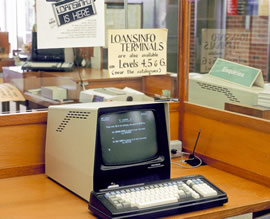
Library management systems
The step-by-step approach to automating Library systems begun the previous decade was sustained into the 1980s with the continued development of in-house systems.
Improving the automation of loans
In 1983, the Library abandoned the Automated Library Systems (ALS) terminals which had been used to handle loans since 1980. The equipment was unreliable and now proved incompatible with the Tattle-Tape security which had begun to be added to library items. The identifying labels which had been laboriously inserted into the 160 000 loanable items in the collection were specific to the ALS terminals, so the whole collection had to be relabeled, this time using barcodes compatible with the new system. 12
Loans desk staff were then able to use light pens to scan the barcodes on books and on borrowers’ library cards to issue loans, resulting in a more efficient service.
LoansInfo and LibInfo
In 1984, in an early move to provide loans information directly to patrons, the Library set up a public access terminal, branded LoansInfo, next to the loans desk in Robertson Library. Patrons were able to independently check whether collection items were on loan and also see their personal loan information.
In 1991, LibInfo was made available to provide online access to information about the Library and its services and also links to other Libraries’ catalogues. 13 It also allowed patrons to renew books online and search the catalogue for items in the reserve collection. Prior to this, reserve items were listed in author and title printouts located in the reserve collection area.
Online searching of the catalogue - KWOCA
Library systems staff developed a Keyword Online Catalogue (KWOCA) which provided limited online access to the monographs (books, audiovisual and other non-journal items) catalogue and allowed cross-field searching 14 for the first time. In 1984, Library staff, on-campus academic staff, and approved off campus users with dial-up access could access KWOCA.
However, the most widely available form of the monograph catalogue was still the microfiche catalogue and journal holdings were still listed by title in a two-volume printed catalogue.
Four years later, access to the online catalogue had expanded to include all users of the University's central computer including students. No authorisation procedure was required. KWOCA had been developed further so that the loan status of collection items could be checked online, allowing patrons to check whether items were available before coming in to the Library in search of them.
However, it was 1992 before the Library launched an online catalogue that searched both the monograph and journal collections and let clients check holdings and renew items, allowing the microfiche catalogue to be phased out.
Automating the journals catalogue
In 1986, an in-house journals accounting system was completed, marking the first phase of automation for management of journals. Data on journal suppliers, subscriptions and payments, previously held on Roneodex card records, was manually entered into a database holding records of current journals received. For the first time, accurate information on suppliers and expenditure over the year could be extracted and future costs more reliably estimated.
By the following year, the accounting module was further developed to process invoices, handle very large dollar amounts, undertake currency conversions, check discrepancies and produce useful reports.
Electronic security
In 1986, an electronic security system was installed at the entrance/exit to Robertson Library in time for the start of second semester. The security gates combined with the ‘Tattle tape’ security in library items meant that staff no longer needed to check for 'unauthorised lending' by patrons on exit and for the first time, clients were able to bring their bags into the Library.
 The loans desk in the mid 1980s.
The loans desk in the mid 1980s.
Loans were efficiently processed by staff using light pens to scan barcodes on books and audiovisual materials in 1983.
 The LoansInfo terminal in the Library, 1984
The LoansInfo terminal in the Library, 1984
1980ss.jpg) Staff working at the information desk on level three in the 1980s. Note the many printed reference volumes and the microfiche catalogue.
Staff working at the information desk on level three in the 1980s. Note the many printed reference volumes and the microfiche catalogue.
 Library staff checking books at the turnstile exit on level three before the installation of electronic security in 1986.
Library staff checking books at the turnstile exit on level three before the installation of electronic security in 1986.
With the collection protected by Tattle-Tape security and the security gates, staff no longer needed to man the exit point in order to physically check patrons' books and files as a deterrent to theft.